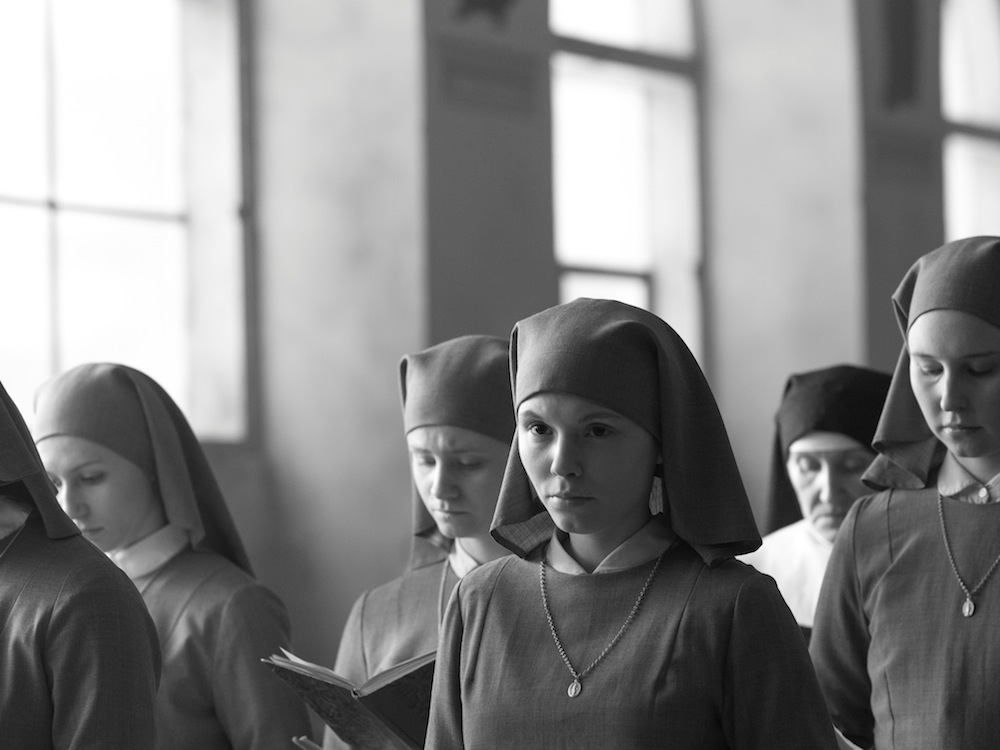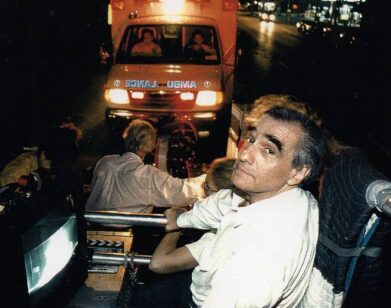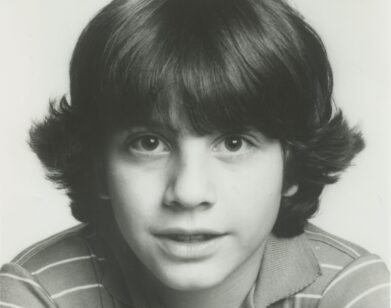Pawel Pawlikowskiâ??s State of Grace
ALL PHOTOS COURTESY OF MUSIC BOX FILMS
There is a stark, austere purity in the face of Agata Trzebuchowska—all angular, convergent planes, marked with brooding dark eyes and a sensitive mouth against milky fair skin. It’s a face, that, when framed in rich black and white by the camera in Pawel Pawlikowski’s latest film, Ida (in which Trzebuchowska stars as the titular character in her first role ever), conjures up a sense of openness, revealing the most nuanced of emotions in every blink or stare.
Set in Poland in 1961, Ida initially introduces its protagonist as Sister Anna, an orphan and novice nun about to take her vows. Before she does, however, her Mother Superior urges her to go out in the world and meet with her last living relative, her aunt Wanda (Agata Kulesza), a disgraced Communist judge haunted by her iron-fisted rulings under Stalin. Wanda reveals that her niece’s name isn’t Anna, but rather Ida—and that she is Jewish, her parents killed under unclear circumstances during World War II. The cosmopolitan Wanda and ethereal Ida take off together on a road trip, weaving through the countryside to contend with the secret, repressed traumas of their family’s and their country’s past, haunted by the post-war specter of Stalinism and the Holocaust.
Pawlikowski, the UK-based director of My Summer in Love and The Woman in the Fifth left communist Poland as a teenager in the ‘70s. This is his first film set in his home country and in the language. It’s a curious homecoming for Pawlikowski, who meditates not only on the memories of his own past, but of Poland’s, without a didactic agenda. Instead, he offers an account of the country’s conflicted post-war period through a character who has minimal understanding of the secular world and whose faith is so strong, she experiences each event, and learns each fact, in a measured state of grace.
Interview spoke to Pawlikowski over tea when he was in New York in January.
COLLEEN KELSEY: Let’s talk about Ida. I was curious, especially after seeing your last film, The Woman in the Fifth, how you moved onto this project. It’s a bit of a departure.
PAWEL PAWLIKOWSKI: The Woman in the Fifth was a very strange film. It started out as a thriller, and it became a really personal, solipsistic film. I had this urge to make a film that was more grounded in history, in a particular time and place that I’m very familiar with and interested in. I also wanted to touch base with something that I’ve been postponing for a long time with my country, because I have too many hang-ups about Poland. I can’t talk straight in Poland. It’s sort of a contorted identity thing, but I also felt ready to make that film. I usually make films about what’s on my mind at any given time.
KELSEY: Was it an emotional homecoming?
PAWLIKOWSKI: You know, film is a long, technical process. I wasn’t emotional most of the time. [laughs] It was just, “How the hell do we get this location or how do we get the money together and how do we find the actors?” But it was good. It was interesting location scouting and just driving around bits and pieces of Poland, which I hadn’t seen for decades. In terms of story, recreating the early ’60s, which I can remember from being a kid, definitely there’s a lot of emotion in the images. They have a lot of resonance. The landscape, the objects in the shot, and this lost world is in my family album somewhere. It was very personal, that stuff.
KELSEY: The film is not a traditional road movie but it plays into that genre a bit. Was that something that you felt was integral in driving the narrative? A certain kind of wandering?
PAWLIKOWSKI: It suddenly became a road movie when I put the two characters together. I started out with seven different sources and seven different ideas. I played with the character of the young novice nun who discovers something about her past that she wasn’t aware of. And then, a different story about this Wanda character, who’s this Stalinist judge with blood on her hands who suddenly loses the ground under her feet and loses faith. I met a character like that some time ago.
KELSEY: The film is stylistically very striking. I think the choice of black and white was appropriate for creating a certain authenticity to the era, as well as the aspect ratio. Were you looking at any other films? Any Polish films from the period?
PAWLIKOWSKI: Not specifically. I grew up cinematically in the ’70s. I was watching a lot of Godard, Bresson, Dreyer, and all sorts of old films and the Czech New Wave. I wasn’t specifically looking at them, but they were in the back of my head, of course. It was a lot of images of my family album and the way I remember that period broadly through films of that period, but also through photographs. I just felt like it was the best way to bring it to life. In black and white, you really look at things. The shape of things matters much more. You’re limited to certain things, suggesting a lot by not showing very much. That was the strategy of the whole thing. Also, the dialogue and everything was trying to make things resonant without spelling too much out or showing too much. It affects your imagination. You have to fill in the rest.
KELSEY: And it allows us to focus on Agata [Trzebuchowska]’s beautiful face, which is so open. That gave me a way into the film. She’s an unknown actor. What was the process of finding her?
PAWLIKOWSKI: I was looking high and low for real actors that could do it, or students of drama. I couldn’t find anyone. Then, a friend of mine saw her in a café in Warsaw. She was a cool hipster. This friend knew I was looking for a young actress and I was desperate. I told all my friends, “Wherever you see someone who is vaguely in the right ballpark, take a secret photograph and send it to me.” [Kelsey laughs] That’s what this friend did. Externally, Agata didn’t look like the part at all, but there was something striking about her. When I invited her for an audition, she came in because she knew my films—she wasn’t interested in acting at all.
KELSEY: What does she do?
PAWLIKOWSKI: She’s a student of philosophy and history. She took time off at the university, with a guilty conscience. She was great. She could take pressure. The beautiful thing about her was that she was not actress-y at all. She didn’t have a histrionic bone in her body. She doesn’t grimace at all, which kind of fits into this idea that this girl in the convent has nobody to grimace at. She thinks before she speaks. She has these mechanics that I imagined Ida should have. She’s very calm, observes things and processes them, and then speaks when she really needs to speak. All these things coincided with what I needed Ida to do, which are not easy to act. Mind you, she did act it. It was acting when she did it. She wasn’t just playing herself. She knew exactly why she was doing something at a certain time. She occasionally challenged my reasons for doing things.
KELSEY: In putting those two together, Ida and Wanda… I found them really interesting not as two polar opposites, but perhaps as two extreme sides of a person. I was curious about how you wanted to create the dynamic between the two of them and what they received from the other? Ida is discovering so much, and those past discoveries have haunted Wanda.
PAWLIKOWSKI: She’s hidden a lot, and Ida’s presence brings it all out. They impact each other interestingly. In the end, Ida seems to be the stronger character because she’s less conflicted. She has a different sort of temperament. What they do have in common is that they both have faith, or had faith, and they need faith. Wanda’s faith evaporated with the moral collapse of Stalinism. This heroic period of communism, where you’re building a new society, was no longer possible, and Wanda loses her position of power in a sense of narrative. Whereas Ida has a different sort of faith, which she almost loses, but doesn’t really. It’s easier to lose faith in something like Marxism, which is kind of a concrete thing, which is supposed to shape society. Whereas faith that’s not measureable is possibly less easy to damage, to destroy it. But they are both strong women. They are made of the same material in some way. But they have a different imagination. They have different ideas in their heads.
KELSEY: Especially in the one sequence where Ida dresses in Wanda’s clothes and attempts to live her life for a little bit.
PAWLIKOWSKI: Yeah, but without any great conviction. [laughs] More like, “I have to try it out.”
KELSEY: But she ends up rejecting the secular world. Do you see Ida as an idealist?
PAWLIKOWSKI: There’s a kind of psychology that’s not typical. She’s not usual. She’s one of these genuinely spiritual creatures. She doesn’t need life and what it has to offer, especially the life of Poland in 1961. So, she’s an unusual character. I asked the audience at a film festival, and they identified more with Wanda and her contradictions. But Ida is a particular character. I don’t know. She’s not like you and me. [laughs] Well, I don’t know about you, but…
KELSEY: I think that most of us can relate to the complexities of Wanda a bit more. What about the post-war era in Poland did you specifically want to explore?
PAWLIKOWSKI: Yeah, this kind of moment where life seems possible again after the ravages of the war and after Stalinism, which was kind of a period of utter terror, but also a period of idealism. Then, suddenly there’s a kind of normality—like, music: you’re dancing and a bunch of life’s vitality comes back. That clash of the two things is kind of interesting. It’s always most interesting for culture, for music, when it’s measured against its opposite. You really see it in focus. That period was a really creative time in Poland with music, theater, and cinema. A degree of freedom came after a period of total unfreedom. It was an interesting time. But also in terms of all these frozen things, Wanda is keeping what she knows frozen for a long time, then suddenly things are opened up and she has to air them because of her niece. Suddenly, she’s exposed to her hidden tragedy. There are a lot of hidden things when a degree of freedom arrives and suddenly you come out into the open.
The same thing happened after ’89. Communism collapsed and all sorts of things could be discussed. There wasn’t any kind of free debate or free access to information at all. So, suddenly, all sorts of traumas come out in these periods. The early ’60s was already something in that direction. But also, I wanted to show Poland as a cool country, strangely. I quite like the style, and the shape of the cars, and the attitude and the people. I think it was a kind of original place with an original youth culture.
KELSEY: Was most of the music in the film from Polish artists of the period?
PAWLIKOWSKI: It was. It was a real explosion—there were a lot of singers and bands. With Stalinism, pop music was banned. So suddenly there was this kind of light pop inspired by Italian music and French music and rock-‘n’-roll from the States. They were sweet, positive, optimistic songs, which were a real reaction to the grimness that preceded in the ’50s and ’40s. The jazz is another thing. Poland was a serious jazz country from the late ’50s onward. Jazz had also been banned by the communists and it was still banned in other countries. I don’t think there wasn’t any jazz in Russia. But Poland was the most open society to the West at the time. So jazz was a huge thing and there were some really great musicians at the time. Ida connects especially with that one tune, “Naima,” by John Coltrane. The pop songs just wash over her, but when she hears that, she kind of falls in love. That opens her up.
IDA IS OUT IN LIMITED RELEASE TOMORROW AT FILM FORUM AND LINCOLN PLAZA CINEMAS







